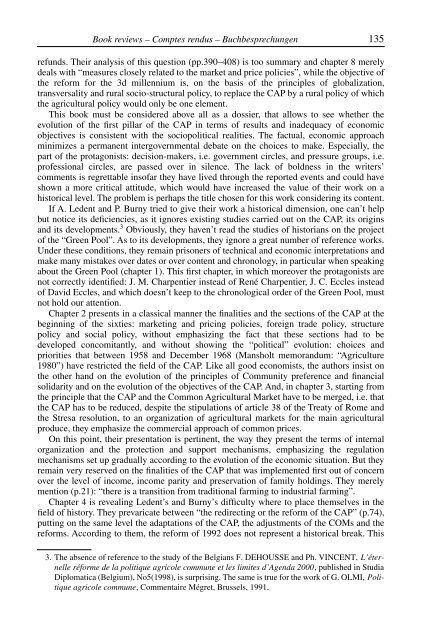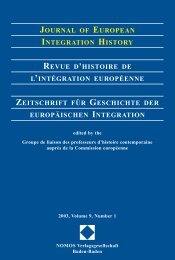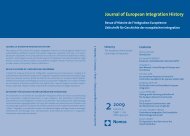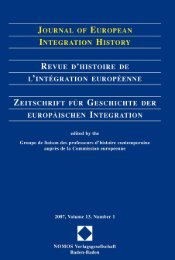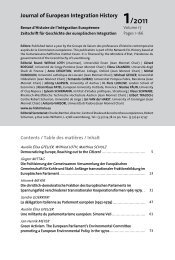journal of european integration history revue d'histoire de l ...
journal of european integration history revue d'histoire de l ...
journal of european integration history revue d'histoire de l ...
Create successful ePaper yourself
Turn your PDF publications into a flip-book with our unique Google optimized e-Paper software.
Book reviews – Comptes rendus – Buchbesprechungen 135refunds. Their analysis <strong>of</strong> this question (pp.390–408) is too summary and chapter 8 merely<strong>de</strong>als with “measures closely related to the market and price policies”, while the objective <strong>of</strong>the reform for the 3d millennium is, on the basis <strong>of</strong> the principles <strong>of</strong> globalization,transversality and rural socio-structural policy, to replace the CAP by a rural policy <strong>of</strong> whichthe agricultural policy would only be one element.This book must be consi<strong>de</strong>red above all as a dossier, that allows to see whether theevolution <strong>of</strong> the first pillar <strong>of</strong> the CAP in terms <strong>of</strong> results and ina<strong>de</strong>quacy <strong>of</strong> economicobjectives is consistent with the sociopolitical realities. The factual, economic approachminimizes a permanent intergovernmental <strong>de</strong>bate on the choices to make. Especially, thepart <strong>of</strong> the protagonists: <strong>de</strong>cision-makers, i.e. government circles, and pressure groups, i.e.pr<strong>of</strong>essional circles, are passed over in silence. The lack <strong>of</strong> boldness in the writers’comments is regrettable ins<strong>of</strong>ar they have lived through the reported events and could haveshown a more critical attitu<strong>de</strong>, which would have increased the value <strong>of</strong> their work on ahistorical level. The problem is perhaps the title chosen for this work consi<strong>de</strong>ring its content.If A. Le<strong>de</strong>nt and P. Burny tried to give their work a historical dimension, one can’t helpbut notice its <strong>de</strong>ficiencies, as it ignores existing studies carried out on the CAP, its originsand its <strong>de</strong>velopments. 3 Obviously, they haven’t read the studies <strong>of</strong> historians on the project<strong>of</strong> the “Green Pool”. As to its <strong>de</strong>velopments, they ignore a great number <strong>of</strong> reference works.Un<strong>de</strong>r these conditions, they remain prisoners <strong>of</strong> technical and economic interpretations andmake many mistakes over dates or over content and chronology, in particular when speakingabout the Green Pool (chapter 1). This first chapter, in which moreover the protagonists arenot correctly i<strong>de</strong>ntified: J. M. Charpentier instead <strong>of</strong> René Charpentier, J. C. Eccles instead<strong>of</strong> David Eccles, and which doesn’t keep to the chronological or<strong>de</strong>r <strong>of</strong> the Green Pool, mustnot hold our attention.Chapter 2 presents in a classical manner the finalities and the sections <strong>of</strong> the CAP at thebeginning <strong>of</strong> the sixties: marketing and pricing policies, foreign tra<strong>de</strong> policy, structurepolicy and social policy, without emphasizing the fact that these sections had to be<strong>de</strong>veloped concomitantly, and without showing the “political” evolution: choices andpriorities that between 1958 and December 1968 (Mansholt memorandum: “Agriculture1980”) have restricted the field <strong>of</strong> the CAP. Like all good economists, the authors insist onthe other hand on the evolution <strong>of</strong> the principles <strong>of</strong> Community preference and financialsolidarity and on the evolution <strong>of</strong> the objectives <strong>of</strong> the CAP. And, in chapter 3, starting fromthe principle that the CAP and the Common Agricultural Market have to be merged, i.e. thatthe CAP has to be reduced, <strong>de</strong>spite the stipulations <strong>of</strong> article 38 <strong>of</strong> the Treaty <strong>of</strong> Rome andthe Stresa resolution, to an organization <strong>of</strong> agricultural markets for the main agriculturalproduce, they emphasize the commercial approach <strong>of</strong> common prices.On this point, their presentation is pertinent, the way they present the terms <strong>of</strong> internalorganization and the protection and support mechanisms, emphasizing the regulationmechanisms set up gradually according to the evolution <strong>of</strong> the economic situation. But theyremain very reserved on the finalities <strong>of</strong> the CAP that was implemented first out <strong>of</strong> concernover the level <strong>of</strong> income, income parity and preservation <strong>of</strong> family holdings. They merelymention (p.21): “there is a transition from traditional farming to industrial farming”.Chapter 4 is revealing Le<strong>de</strong>nt’s and Burny’s difficulty where to place themselves in thefield <strong>of</strong> <strong>history</strong>. They prevaricate between “the redirecting or the reform <strong>of</strong> the CAP” (p.74),putting on the same level the adaptations <strong>of</strong> the CAP, the adjustments <strong>of</strong> the COMs and thereforms. According to them, the reform <strong>of</strong> 1992 does not represent a historical break. This3. The absence <strong>of</strong> reference to the study <strong>of</strong> the Belgians F. DEHOUSSE and Ph. VINCENT, L’éternelleréforme <strong>de</strong> la politique agricole commune et les limites d’Agenda 2000, published in StudiaDiplomatica (Belgium), No5(1998), is surprising. The same is true for the work <strong>of</strong> G. OLMI, Politiqueagricole commune, Commentaire Mégret, Brussels, 1991.


